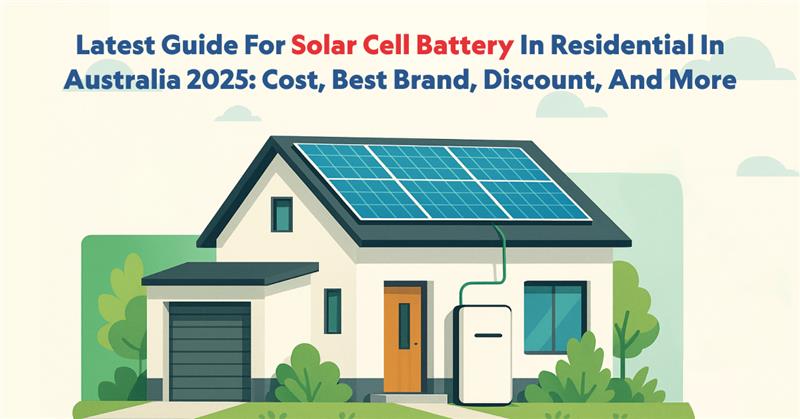As an experienced product retailer with more than 15 years in the renewable energy sector, I have noticed that the solar industry in Australia is evolving from adoption to a mainstream requirement.
Increasing energy costs, frequent blackouts, and pressure on the emissions of net-zero; solar batteries are no longer a luxury. They are a smart investment for the owners of the houses to maximize the solar layout. In 2025, thanks to liberal federal and state encouragement, it will never be more economical or attractive to install a solar system.
Whether you do a solar business or give advice to customers, this wide guide includes everything from basic things to advanced ideas, drawing the latest data from industry reports, government sources, and expert analyses. Let’s dive in and find out how these solar systems can provide constant strength effectively and constantly to Australian homes.
Why Solar Battery is the Next Big Step for Homeowners?
Australia has one of the highest levels of solar radiation in the world, making solar energy a natural alternative for homeowners. However, when solar panels on the roof generate electricity during the day, most of that energy is lost when not used instantly.
Going with a solar battery on your home – the right way to store excess solar energy and use it when you need the most.
In this article, we will cover Solar Cell Battery:
• What is a solar battery?
• Benefits for Australian Home
• Cost, exemption, and encouragement
• Select the right sun battery
Program Tide Line & Rollout
• Date of Launch: July 1, 2025 or before. It will be declared near the exact start date.
• Staging Around: Applications are opened in waves (to handle demand) from mid -2012 as per wa.gov.au. The stakeholders will provide advanced information for each round.
• Period: The plan (20,000 discounts) will go to the funds are exhausted. Depending on the declared promise (~ 387 million dollars), it is expected to support around 20,000 companies.
• Sign up: Interested families and companies must now register their interest (WA Battery Scheme Mailing List) to get updates. Register here as a house or here as a dealer/installer.
What are Solar Batteries and How do they Work?
Residential Solar Battery stores the extra power generated by the solar panels on the roof during the day, so you can use it at a later stage, for example, evening or during an electric power failure etc. In essence, they convert your home into a mini power plant, which reduces the dependence on the grid.
Here is a simple collapse:
• Solar panels generate energy: Solar cell system (PV) converts sunlight to DC power.
• A reformer converts it: A converter converts DC to AC for the use of a house.
• Battery shop surplus: Instead of exporting more to the grid (often on low feed tariffs), the battery saves it for high demand for the time.
In Australia, where solar entry is the highest global (more than 3.5 million houses have panels), the battery addresses the “duck curve” problem – where today’s over experience meets the evening stops. According to government data, the batteries can help the houses achieve 80-90% energy self-supply if the battery is connected to solar energy.
Most of the systems are “Hybrid” setups, which are compatible with existing photovoltaic systems via AC-horns (adding battery to an old system) or DC-eille (integrated from start).
Types of Solar Batteries Available in Australia
Not all batteries are made to the same specifications. The Australian market offers a variety of types, each with professionals, resistance, and non-profit matters. Depending on today’s trends, lithium-ion dominates due to efficiency and lifetime value.
| Type | Description | Pros | Cons | Popular in Australia? |
| Lithium-Ion (Li-ion) | Includes subtypes like NMC (Nickel Manganese Cobalt) and LFP (Lithium Iron Phosphate). Compact and high-energy density. | High efficiency (90-95%), long lifespan (10-15 years), low maintenance. | Higher upfront cost; LFP is safer but slightly less dense. | Yes—over 90% of installations; brands like Tesla use LFP. |
| Lead-Acid | Traditional flooded or sealed batteries, similar to car batteries. | Cheapest option; recyclable. | Short lifespan (3-5 years), low efficiency (70-80%), requires ventilation. | Rarely for new homes; phased out for modern solar. |
| Flow Batteries | Use liquid electrolytes (e.g., vanadium redox). | Long cycle life (20+ years), fully dischargeable without damage. | Bulky, expensive, lower efficiency. | Niche; Redflow ZCell is a local favorite for off-grid setups. |
| Nickel-Cadmium (Ni-Cd) | Robust for extreme conditions. | Tolerant to overcharge/discharge. | Toxic materials, high cost, environmental concerns. | Uncommon in residential use due to regulations. |
Lithium-ion batteries, especially LFPs, are two for most Australian homes in 2025, as they better cope with our warm climate and qualify for discounts. For your sunshine, the recommendation of LFP options may emphasize safety and durability.
Big Benefits of Installing a Solar Battery
Why care about a battery? In a country like Australia, where electricity prices are on average 25-35 cents per kWh and input tariffs as low as 5-10 øre, mathematics is quickly connected.
• Bill Savings: Save cheap solar energy and avoid buying top-time networks. Average homes save $ 800-1,500 per year, with a PIMC with a copy of 5-8 years.
• Energy -relay: Use the power stored during blackouts in stormy areas such as Queensland or Bushfire Zone in NSW.
• Environmental Effects: Reduce carbon footprint by reducing fossil fuels. Australia is aiming for 82% renewable energy by 2030, and the battery plays an important role.
• Increase in Property Value: Selling home for 3-5% more with Solar + batteries, according to real estate data.
• Grid Support: Participate in virtual power plants (VPP) for extra revenue, such as Tesla’s program in South Australia.
With an increase of 2025 in installations (“away from charts”), the battery changes how Australians use energy.
Best Housing Battery in Australia for 2025
Based on the voices from 161 Australian solar installers on the 2025 Installer Choice Awards, there are top pictures. These brands are distinguished by reliability, warranty, and compatibility.
1. Tesla Powerwall (First Place TIE): 13.5 kWh capacity, seamless app integration, 10 -year -old warranty. Ideal for smart homes; Leaves VPP well. Price: ~ $ 12,000 established before a discount.
2. Sungrow (First Location TIE): Cheap AC-EXTER options such as SBR series (9.6-25.6 kWh). great value; Expandable. This is popular amongst Budget-conscious customers.
3. Sign (second place): Emerging Star with modular designs; High efficiency and fast charging.
4. Byd: Reliable Chinese brand; Modular battery with a 10-year warranty (eg, battery box). Good for large systems.
5. Alpha’s: versatile; Strong in a hybrid layout. It is often famous for its customer service.
6. Enphase IQ Battery: Microinverter-SANTRA; Scalable from 3.5 kWh. The best for single-phase solar owners.
7. Redflow Zcelal: Australian team float battery; Excel in deep-off-green discharge.
Installers favour Tesla and suggest it for its perfect track record under Australian circumstances. For your business, they can promote client confidence – always check CEC approval for the calculation of a discount.
Cost of Solar Battery in 2025
The cost has dropped significantly for Global Supply Chains and Local Incentives. It is expected to pay $ 700-1,000 per kWh in the previous years, below $ 1200+.
• average prices (established, before discount):
O 5 kWh: $ 5000- $ 7000
O 10 kWh: $ 8000- $ 13,000
O 15 kWh: $ 15,000- $ 18,000
Solar option index from August 2025:
• 10 kWh: ~ $ 9000 ($ 900/kWh)
• 13 kWh (popular size as Tesla): ~ $ 10,218 ($ 786/kWh)
Costs Affecting Factors: brand, capacity, installation complexity (eg, garage vs. outdoors). Add $ 1,000-2,000 to the hybrid converter if necessary.
Discount and Incentive: Make the Battery Cheaper in 2025
The government of Australia will adopt supercharging with the cheap battery program that was launched on July 1, 2025. It offers ~ 30% discount on qualified systems (up to $ 3000- $ 5000 from a 10 kWh battery). Qualification: New or existing SOL, CEC-END products, established by reputable professionals.
State breakdown:
• NSW: November 2024 to $ 1500 incentives; Stable with federal.
• Victoria: $ 1000+ via Solar Victoria; Already more than 2025 goals.
• Queensland: interest-free loan up to $ 3000.
• South Australia: VPP supplements; Historically up to $ 6000.
• WA: State Discount with Stack Federal ~ $ 4000 for total savings.
Overall, discount costs can be up to 30-50%, reducing paybacks by 4-6 years for highly utilized homes. Check Enry.gov.au for updates.
Establishment and maintenance: Ensure long service life
Establishment: Always use a recognized installer for Clean Energy Council (CEC) – it is mandatory for discounts. The process takes 1-2 days:
• Evaluation of the site (shaded, ventilated place; liked indoor lithium).
• Cabling: AC-egged for retrofitting, DC for New.
• Test: Provide compatibility with your solar system.
Cost: Included in quotes, but add $ 500-1,000 to complex jobs. The security first match must meet AS/NZS standards to avoid fire risk.
Maintenance: Lithium battery requires little maintenance.
• Do: Monitor through the app, place at 20-25 ° C (avoid more than 40 ° C garage), annually pure dust.
• Dons: overcharging, exposing water, or ignoring the notice.
• Services every 2 years from a qualified electrician (~ $ 200).
• Guarantee coverage 10+ years; Expect 6,000-10,000 cycles.
Regular checks extend life and provide maximum return advice for their solar cells.
Are Solar Batteries Worth It in 2025? Payback and Future Trends
With a discount, yes – for most. A 10 kWh system can save $ 1000/year, pay back in 6 years. Household houses (EG. EVS, Pool) see quick returns.
Trends: Modular battery for scalability, AI adaptation, and integration with smart networks. By 2030, 3 out of 3 solar houses will have batteries.
Conclusions: Power to your home (and business) with Green Energy
Housing batteries are a game-changer in Australia and offer savings, safety, and stability. The 2025 discount makes them more accessible; now it’s time to invest. For solar companies, educating customers about these options can boost sales with iconic brands and installers for the best results. Are you ready to go with Solar power? Contact a local solar system specialist or energy expert for personal advice.





